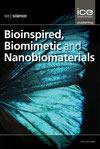Mg/PCL静电纺膜的制备及初步研究
IF 0.6
4区 工程技术
Q4 ENGINEERING, BIOMEDICAL
引用次数: 0
摘要
金属镁(Mg)及其合金降解产物镁离子(Mg2+)能刺激骨细胞的代谢活性,有利于骨的生长和愈合。以可生物降解聚己内酯(PCL)和镁颗粒为原料,采用静电纺丝技术制备掺杂镁颗粒的静电纺丝膜材料。同时,采用扫描电子显微镜、x射线衍射分析技术和微机控制的电子万能试验机对材料的物理化学性能进行分析。通过体外细胞实验,评价了电纺丝膜的生物相容性及其诱导人牙髓干细胞成骨分化的潜力。结果表明,采用静电纺丝技术成功制备了掺杂镁颗粒的镁/PCL静电纺丝膜,该材料具有良好的多孔结构。镁/PCL电纺丝膜具有良好的生物相容性,具有诱导hdpsc成骨分化的潜力。其中,10%镁/PCL静电纺膜的效果最为明显。在临床上,这些材料为牙槽骨缺损的修复提供了新的思路,为实现牙槽骨再生提供了实验依据。本文章由计算机程序翻译,如有差异,请以英文原文为准。
Preparation of Mg/PCL electrospun membranes and preliminary study
Magnesium (Mg) metal and its alloy degradation product magnesium ion (Mg2+) can stimulate the metabolic activity of bone cells, which is beneficial to bone growth and healing. With biodegradable polycaprolactone (PCL) and magnesium particles as raw materials, electrospinning technology is used to prepare electrospun membrane materials doped with magnesium particles. Meanwhile, the scanning electron microscope, X-ray diffraction analysis technology and microcomputer-controlled electronic universal testing machine are adopted to analyze the physical and chemical properties of the material. The biocompatibility of electrospun membranes and their potential to induce osteogenic differentiation of human dental pulp stem cells (hDPSCs) were evaluated by in vitro cell experiments. The results showed that magnesium/PCL electrospun membranes doped with magnesium particles were successfully prepared with electrospinning technology, and the material has a good porous structure. Magnesium/PCL electrospun membranes have good biocompatibility and have the potential to induce osteogenic differentiation of hDPSCs. Among them, the effects of 10% magnesium/PCL electrospun membranes were the most obvious. Clinically, these materials provide new ideas for the restoration of alveolar bone defects and provide an experimental basis for the realization of alveolar bone regeneration.
求助全文
通过发布文献求助,成功后即可免费获取论文全文。
去求助
来源期刊

Bioinspired Biomimetic and Nanobiomaterials
ENGINEERING, BIOMEDICAL-MATERIALS SCIENCE, BIOMATERIALS
CiteScore
2.20
自引率
0.00%
发文量
12
期刊介绍:
Bioinspired, biomimetic and nanobiomaterials are emerging as the most promising area of research within the area of biological materials science and engineering. The technological significance of this area is immense for applications as diverse as tissue engineering and drug delivery biosystems to biomimicked sensors and optical devices.
Bioinspired, Biomimetic and Nanobiomaterials provides a unique scholarly forum for discussion and reporting of structure sensitive functional properties of nature inspired materials.
 求助内容:
求助内容: 应助结果提醒方式:
应助结果提醒方式:


